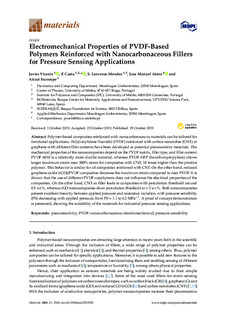Título
Electromechanical Properties of PVDF-Based Polymers Reinforced with Nanocarbonaceous Fillers for Pressure Sensing ApplicationsFecha de publicación
2019Otras instituciones
Universidade de Minho (Portugal)Institute for Polymers and Composites (IPC)
Ikerbasque
Universidade de Minho (Portugal)
Universidad del País Vasco/Euskal Herriko Unibertsitatea (UPV/EHU)
Versión
Version publicadaTipo de documento
ArtículoArtículoIdioma
InglésDerechos
© 2019 by the authorsAcceso
Acceso abiertoVersión de la editorial
https://doi.org/10.3390/ma12213545Publicado en
Materials Vol. 12. Nº 21. 3545. October, 2019Editorial
MDPI AGPalabras clave
piezoresistivity
PVDF
nanocarbonaceous
electromechanical ... [+]
PVDF
nanocarbonaceous
electromechanical ... [+]
piezoresistivity
PVDF
nanocarbonaceous
electromechanical
pressure sensibility [-]
PVDF
nanocarbonaceous
electromechanical
pressure sensibility [-]
Resumen
Polymer-based composites reinforced with nanocarbonaceous materials can be tailored for functional applications. Poly(vinylidene fluoride) (PVDF) reinforced with carbon nanotubes (CNT) or graphene wit ... [+]
Polymer-based composites reinforced with nanocarbonaceous materials can be tailored for functional applications. Poly(vinylidene fluoride) (PVDF) reinforced with carbon nanotubes (CNT) or graphene with different filler contents have been developed as potential piezoresistive materials. The mechanical properties of the nanocomposites depend on the PVDF matrix, filler type, and filler content. PVDF 6010 is a relatively more ductile material, whereas PVDF-HFP (hexafluropropylene) shows larger maximum strain near 300% strain for composites with CNT, 10 times higher than the pristine polymer. This behavior is similar for all composites reinforced with CNT. On the other hand, reduced graphene oxide (rGO)/PVDF composites decrease the maximum strain compared to neat PVDF. It is shown that the use of different PVDF copolymers does not influence the electrical properties of the composites. On the other hand, CNT as filler leads to composites with percolation threshold around 0.5 wt.%, whereas rGO nanocomposites show percolation threshold at ≈ 2 wt.%. Both nanocomposites present excellent linearity between applied pressure and resistance variation, with pressure sensibility (PS) decreasing with applied pressure, from PS ≈ 1.1 to 0.2 MPa−1. A proof of concept demonstration is presented, showing the suitability of the materials for industrial pressure sensing applications. [-]
Sponsorship
Gobierno VascoID Proyecto
GV/Elkartek 2019/ KK-2019/00051/Utillaje adaptable, inteligente y dinámico en la industria aeronáutica 4.0/SMARTRESNAKColecciones
- Artículos - Ingeniería [762]
El ítem tiene asociados los siguientes ficheros de licencia:






















